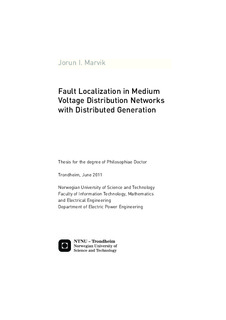| dc.description.abstract | Being part of a larger research project named “Distribution 2020”, the focus of this work has been on increasing the automation of the fault handling in distribution networks, taking into consideration the increasing number of distributed generation (DG) units. The main goal of this work has been to investigate, and further develop methods for locating short circuit faults in distribution networks, with possible presence of DG-units. Also, the developed methods should be simple, and the use of measurements communicated from other locations than the substation should be kept at a minimum. Finally, the fault localization methods should be applicable for a general network. The development of such general methods is meant to be a step towards a more automated fault handling in distribution networks, leading to increased network reliability and reduced outage costs.
Fault data have been generated through simulations in the transient electromagnetic program PSCAD, where a simple model of a medium voltage (MV) distribution network was developed. Short circuit data from a real network was not available for this work. A distribution network may have various appearances, as the total length, number of branches, loading, short circuit capacity and other parameters may vary greatly, and generalizing the characteristics for a typical distribution network is not possible. The model parameters are chosen based on real network data, but the model is typically simplified compared to a real network.
This work has focused on short circuit faults. Fault simulations have been performed for a feeder without DG, with one DG- and with three DG-units. The impacts of various parameters on the distance estimate obtained by use of conventional distance relays have been investigated. Focus in the investigation was to find which parameters that impact most on the accuracy, and on quantifying the errors in the estimates. It is shown how load and DG introduce substantial errors in the distance estimates from traditional distance relays, and that there is a need for methods to compensate for these impacts in order to obtain a fault localization of sufficient accuracy.
Two methods for compensation of the impact from the load and DG-unit(s) on the distance estimates are presented. Both methods make use of pre-fault measurements from the DG-unit together with pre-fault substation measurements, and make rough estimations of the pre-fault load distribution on the feeder. In method 1 the required DG-quantities during fault are estimated, while in method 2 the DG voltage- and current- magnitude and the power factor angle are available from measurements. Requiring only magnitude values from the DG allows for simple communication solutions. In both method 1 and 2 a simple lumped feeder model is utilized for analytical estimation of unknown quantities. This includes estimation of the DG voltage phasor angle referred to the substation voltage.
The estimated DG currents during fault in method 1 are quite accurate, especially for twophase short circuits, as seen in Ch. 6.2.5. For three-phase short circuits the estimated currents are generally a bit higher than the simulated. This results in overcompensation of the impact due to the DG in the distance-to-fault estimation. Despite of the overcompensation, the accuracy is improved with compensation 1 in most cases. The improvement is however dependent on the DG location. With a three-phase short circuit at the end of a 30 km long feeder, the largest improvement is seen when the DG is located close to (5 km) the substation, with a reduction of the error from +7.8 km to -1 km. The lowest accuracy of the compensated estimate is obtained when the DG is located at the middle of the feeder. The error is then -1.9 km, which still is an improvement compared to worst case without compensation. The estimates obtained at high load are only slightly more accurate than for low load, despite of the larger difference without compensation. If the DG location is fixed and the fault location is varied, the accuracy of the compensated estimate is decreasing as the fault is moved away from the substation, and the lowest accuracy is obtained when the fault is at the feeder-end. Generally, compensation method 1 results in larger improvement of the accuracy for twophase short circuits, than for three-phase.
In method 2, measurements of the DG current- and voltage- magnitudes and the power factor angle during fault are utilized, and very accurate distance estimates are obtained for all cases (largest error with compensation 2 for the shown cases is 0.7 km). The DG-voltage phasor angle relative to the substation voltage is estimated from the lumped feeder model, like in the pre-fault state. The distance estimates are very accurate for all fault cases, so to have measurements from the DG during fault is very advantageous.
If the DG voltage magnitude is available during fault it can be utilized for finding the correct faulted branch if there is more than one candidate location. A method where the corresponding DG voltage is estimated for each possible fault location has been suggested. For the example feeder the smallest difference between the estimated and simulated voltage magnitudes corresponded to the correct fault location in all cases. Measurements from the DG-unit during fault result in both more accurate distance estimates and can be used to decide the correct faulted branch, and to have such measurements is therefore very beneficial. | nb_NO |
